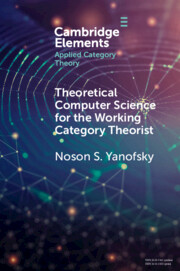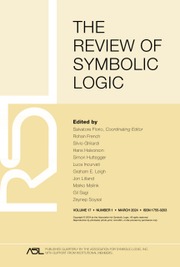An Invitation to Applied Category Theory
Seven Sketches in Compositionality
- Authors:
- Brendan Fong, Massachusetts Institute of Technology
- David I. Spivak, Massachusetts Institute of Technology
- Date Published: July 2019
- availability: Available
- format: Paperback
- isbn: 9781108711821
Paperback
Other available formats:
Hardback, eBook
Looking for an inspection copy?
Please email [email protected] to enquire about an inspection copy of this book
-
Category theory is unmatched in its ability to organize and layer abstractions and to find commonalities between structures of all sorts. No longer the exclusive preserve of pure mathematicians, it is now proving itself to be a powerful tool in science, informatics, and industry. By facilitating communication between communities and building rigorous bridges between disparate worlds, applied category theory has the potential to be a major organizing force. This book offers a self-contained tour of applied category theory. Each chapter follows a single thread motivated by a real-world application and discussed with category-theoretic tools. We see data migration as an adjoint functor, electrical circuits in terms of monoidal categories and operads, and collaborative design via enriched profunctors. All the relevant category theory, from simple to sophisticated, is introduced in an accessible way with many examples and exercises, making this an ideal guide even for those without experience of university-level mathematics.
Read more- Contains more than 200 fully worked-out exercises for students to test their understanding
- Collects many examples of applied category theory in one place, a useful resource for researchers
- Provides an accessible introduction to category theory for non-mathematicians
- Enriched with many colour diagrams
Reviews & endorsements
'Category theory was always applied, but traditionally within pure mathematics. Now it is being used to clarify and synthesize a broad range of topics outside mathematics: from computer science to linguistics, from quantum theory to chemistry, and beyond. Charmingly informal yet crystal clear, Fong and Spivak's book does a wonderful job of demonstrating the power of category theory to beginners – even beginners without much background in pure mathematics.' John Baez, University of California, Riverside
See more reviews'The authors quite rightly describe category theory as a tool for thinking. So if your work requires thinking, this book is for you.' Bartosz Milewski, author of Category Theory for Programmers
'This book provides a fantastic introduction to how category is not just abstract nonsense but can be applied to real-world engineering problems, pedagogical while still broad, and fun. A must read for all those entering the exciting emerging field of applied category theory by two key players of this community.' Bob Coecke, University of Oxford
'An invitation to Applied Category Theory: Seven Sketches in Compositionality provides a grand tour of the fascinating emergent field of applied category theory that centers examples and use cases before gently introducing the accompanying abstract notions. Fong and Spivak should be congratulated for providing this accessible broad viewpoint to illustrate what category theory is all about vis-à-vis the real world.' Emily Riehl, The Johns Hopkins University
'An Invitation to Applied Category Theory is clearly and entertainingly written, and provides a great entry into the world of applied category theory. It is chock full of concrete examples and illustrated with clear diagrams … Fong and Spivak will whet your appetite for learning about categories and how they - and the categorical way of thinking - can be applied in and beyond mathematics. And they will give you the means to do that in a self-contained text.' David Jaz Myers, MAA Reviews
'Fong and Spivak's book is highly recommendable for anyone with even a passing interest in category theory in general. And it is mandatory reading for scholars aiming to apply category theory to real world problems.' Fernando A. Tohme, MathSciNet
'The presentation is highly visual, employing graphs (nodes and edges), directed graphs, and hypergraphs. In addition, exercises intersperse each presentation, and the solutions to many of the exercises are included. Finally, the chapters include concluding summaries, with suggestions for further study. The book contains scores of references. In short, an excellent self-study resource for those interested in learning about applications of category theory to real-world problems.' J. T. Saccoman, Choice
'… highly recommended.' Berthold Stoge, IUCr Journals CRYSTALLOGRAPHY JOURNALS ONLINE
Customer reviews
Review was not posted due to profanity
×Product details
- Date Published: July 2019
- format: Paperback
- isbn: 9781108711821
- length: 348 pages
- dimensions: 246 x 173 x 17 mm
- weight: 0.71kg
- contains: 101 b/w illus. 60 colour illus. 240 exercises
- availability: Available
Table of Contents
Preface
1. Generative effects: orders and Galois connections
2. Resource theories: monoidal preorders and enrichment
3. Databases: categories, functors, and universal constructions
4. Collaborative design: profunctors, categorification, and monoidal categories
5. Signal flow graphs: props, presentations, and proofs
6. Electric circuits: hypergraph categories and operads
7. Logic of behavior: sheaves, toposes, and internal languages
Appendix. Exercise solutions
References
Index.-
General Resources
Find resources associated with this title
Type Name Unlocked * Format Size Showing of
This title is supported by one or more locked resources. Access to locked resources is granted exclusively by Cambridge University Press to lecturers whose faculty status has been verified. To gain access to locked resources, lecturers should sign in to or register for a Cambridge user account.
Please use locked resources responsibly and exercise your professional discretion when choosing how you share these materials with your students. Other lecturers may wish to use locked resources for assessment purposes and their usefulness is undermined when the source files (for example, solution manuals or test banks) are shared online or via social networks.
Supplementary resources are subject to copyright. Lecturers are permitted to view, print or download these resources for use in their teaching, but may not change them or use them for commercial gain.
If you are having problems accessing these resources please contact [email protected].
Sorry, this resource is locked
Please register or sign in to request access. If you are having problems accessing these resources please email [email protected]
Register Sign in» Proceed
You are now leaving the Cambridge University Press website. Your eBook purchase and download will be completed by our partner www.ebooks.com. Please see the permission section of the www.ebooks.com catalogue page for details of the print & copy limits on our eBooks.
Continue ×Are you sure you want to delete your account?
This cannot be undone.
Thank you for your feedback which will help us improve our service.
If you requested a response, we will make sure to get back to you shortly.
×


